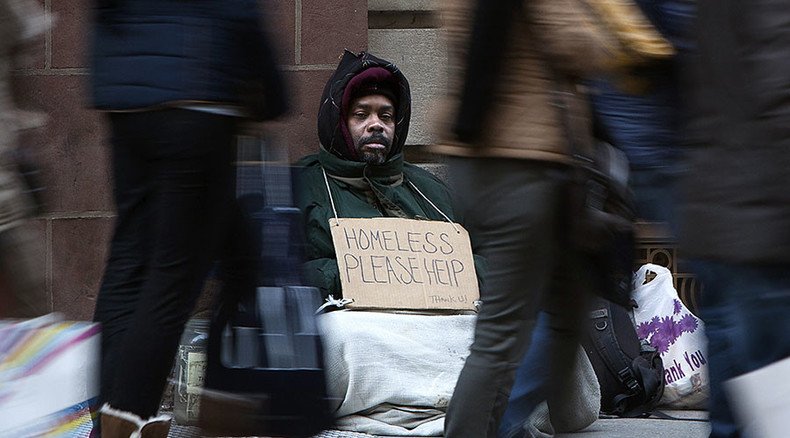New York City homeless population nears 60,000, over 40% are children – report

A tangle of skyrocketing rents, stagnant wages, evictions and a lack of affordable housing has led to a boom in homelessness in New York City. The latest figures show 57,448 people sleeping in shelters, and approximately 40 percent are children.
According to the latest Department of Homeless Services (DHS) figures, more than 23,000 of the 57,448 people sleeping in New York City shelters are children. There are nearly 12,000 families in the shelter system. Organizations that help aid homeless people are getting worried that as the cold weather sets in, the numbers will return to the record high of seen in December 2014, when the homeless population numbered 59,068.
Another point of concern is that homeless people are staying in shelters longer and returning to them within a given year. The DHS said adults are staying an average of 11 months, up 24 days on last years’ data. Families with children are staying 14 months (up three days) and couples are staying an average of nearly 18 months (up 19 days).
Homelessness on the rise in New York? What we know, what we don't know: https://t.co/AZ4WvHMFfm
— Anjali Mullany (@anjalimullany) October 26, 2015Caught in the crosshairs is Mayor Bill de Blasio, who ran a campaign vowing to address income inequality in the city. His administration, however, inherited a homeless population of more than 53,000 people from the Michael Bloomberg administration. Mayor Bloomberg oversaw cuts to three shelters systems and the creation of the dysfunctional Advantage public program, which was intended to help struggling families before its funding was cut. That decision led to a ballooning homeless population – from 37,000 in 2011 to 53,000 within three years, according to the New York Times.
Compounding the problem is that city rents have continued to escalate. Between 2002 and 2011, 39 percent (385,300) affordable apartments were lost. A number of myths persist about homelessness – that people are substance abusers or suffer from mental illness – but the major reason is more fundamental.
“More than two-thirds of the people in our shelters are families with vulnerable children, and the most common cause of their homelessness isn’t drug dependency or mental illness. It’s eviction,” wrote Mary Brosnahan, president and chief executive of the Coalition for the Homeless, in a recent New York Times op-ed.
“If we can slow the pace of evictions, we will make a major dent in the homelessness crisis.”
Hawaii declares state of emergency over homeless problem http://t.co/6O80AvxewApic.twitter.com/pxGL0loaYZ
— RT America (@RT_America) October 17, 2015Brosnahan said the number of families forced from their homes by court order has risen over the past 10 years and is now close to 29,000 annually. Thousands more leave under duress midway through eviction proceedings. She said New Yorkers in housing court currently have no right to counsel, resulting in only 10 percent who hire attorneys to help protect their rights. Meanwhile, close to 100 percent of landlords have attorneys.
In cases where a tenant does have an attorney, they are less likely to get evicted, and landlords simply drop their cases when a tenant is represented.
13K public aid recipients become homeless in LA County every month– report
http://t.co/N1Zv50Byw9pic.twitter.com/ERcyakbGDd
— RT America (@RT_America) August 27, 2015In September, de Blasio announced an additional $12.3 million in funding, representing a tenfold increase over 2014, for a program that helps provide tenants attorneys,. It costs about $2,500 to provide a tenant with an attorney in an eviction proceeding, while the city spends on average of more than $45,000 to shelter a homeless family.
There is also a bill pending in the City Council that would create the right to counsel for all low-income tenants in housing court. If passed, it would make New York City the first in the nation to guarantee representation for tenants. Sponsors feel this would lead to decrease in the number of families forced into homelessness.
In the United States, disaster has become our most common mode of life https://t.co/sIBG7zrFwU
— Ida B Wells KC (@IdaBWellsKC) October 26, 2015What the shelter figures don’t include are the estimated 3,000 – 4,000 more people who sleep on city streets. Some advocates estimate the real number is somewhere between 6,000 and 12,000 people. A recent report found that 300 full-time municipal workers are homeless.
"We live in a city with 1.5m people living below the poverty line - that means we have 1.5m people at risk of being homeless," said Jeff Foreman, policy director of Care for the Homeless, an advocacy group in the city.












